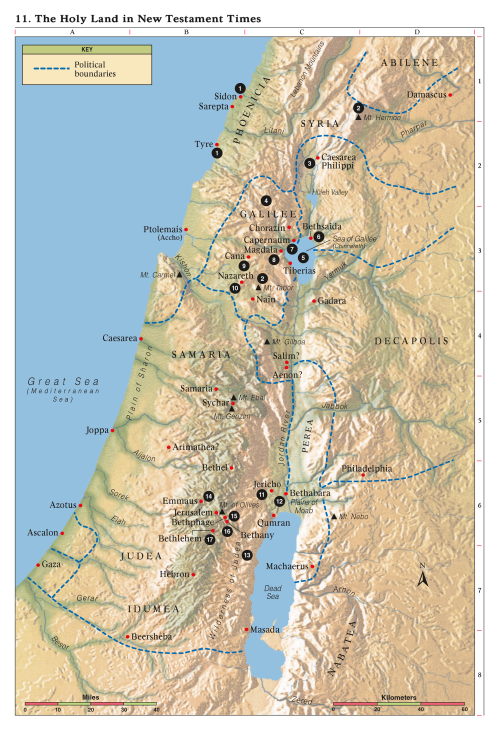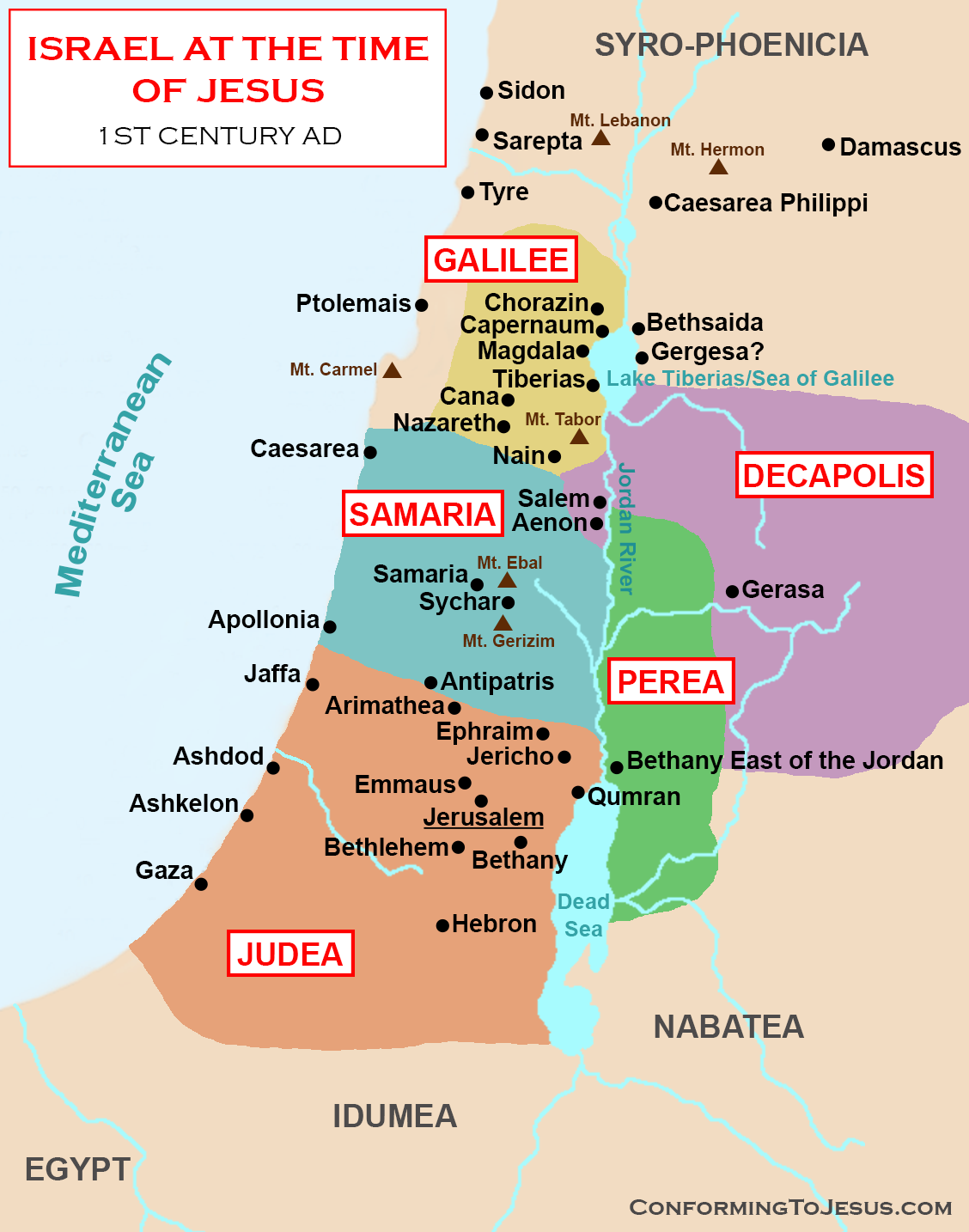The New testament maps of israel focuses on the major events in the life of Jesus Christ according to the gospel accounts. The book, which is a five-volume set, was written by J. Ed Komoszewski, M. James Sawyer and Daniel B. Wallace. They are all professors at different universities and they have written several scholarly books together, including An introduction to the new testament and The gospel of John: A commentary .
New Testament Maps of Israel Maps have been reproduced in New Testament atlases and commentaries for nearly two hundred years, yet the same basic maps continue. As a new generation of Bible readers and scholars become interested in the Jewish geography of the New Testament, it is time for new maps. This article gives answers to question like is the new jerusalem bible accurate?
How did the ancient biblical community of israel interact with specific geographical locations? How did the deceased use these geographic locations and understand them in their religious experience? The answers to these questions are found in the maps included in the New Testament writings. In order to reconstruct a detailed portrayal of survival or movement, ancient Jewish and Christian writers used descriptions of geographical locations throughout their writings. By accepting these maps as factual and accurate descriptions, one can begin to understand the religious landscape of Israel. Following representations on maps, it becomes easy to trace a number of key events in the life of Jesus Christ. You’ll also find soothing answer to is the new jerusalem bible a good translation discussed in the article.

New Testament Maps Of Israel
The New Testament of the Bible is the second part of the Christian Bible. It tells us about Jesus’ life and his death, resurrection and ascension into heaven. The Old Testament contains most of what we know as the Hebrew Bible, which is also known as the Tanakh.
In this article we will look at some of the main events in Israel’s history as they are described in the New Testament. We will also see how these events are depicted on modern maps of Israel.
The New Testament begins with an account of Jesus’ birth, which takes place in Bethlehem (Matthew 2:1-12; Luke 2:4-7). Bethlehem is located in Judea (now southern West Bank), near Jerusalem (see map below). The town was founded around 3000 BC by Canaanites as a small village or hamlet. It became part of Israel during King David’s reign (c 1040 BC) and remained under Jewish control until it was conquered by Babylonians in 586 BC. After Babylonian rule ended, it was rebuilt by Persian king Cyrus II “the Great” in 538 BC along with other cities such as Jerusalem and Samaria (see map below). During Roman times, Bethlehem grew into a prosperous city thanks to its
The New Testament is a collection of 27 separate books, written by a variety of authors from different backgrounds, cultures, and time periods. Its contents include the Gospels (Matthew, Mark, Luke, and John), Acts, Epistles (letters) such as Paul’s letters to various churches or individuals, and Revelation. Though these books were originally written in Greek, they have been translated into many other languages including English.
The maps included in this article were created by Biblia.com in order to help readers understand where the New Testament took place—not just what happened there but also where it happened. The maps are based on historical research and archaeological evidence that has been gathered over many years by scholars around the world. They show locations mentioned in each book as well as other areas where events occurred during that time period such as Jerusalem or Galilee. Some areas are marked with question marks because they do not yet have any evidence supporting them being part of those stories; however there may be more discoveries made on those areas someday!


Is The New Jerusalem Bible Accurate
The Jerusalem Bible, which was originally an English translation of the French Bible de Jérusalem, has been revised and renamed the New Jerusalem Bible. Conventional wisdom holds that the French had little to do with the Jerusalem Bible, which was an original translation heavily influenced by French. Despite claims to the contrary, it is clear that the Jerusalem Bible was translated from the French, possibly with occasional glances at the Hebrew or Greek, rather than vice versa, as Henry Wansbrough, editor of the New Jerusalem Bible, argues. [2]
The Jerusalem Bible was revised and renamed the New Jerusalem Bible to reflect the changes made to the French translation in 1973. The changes were major. In general, the newer version is more literal and has less literary flourishes. One of the most scholarly editions of the Bible, thanks to extensive revisions and expansions of the introductions and footnotes, which were translated almost entirely from the French.
Is The New Jerusalem Bible A Good Translation
English-speaking audiences were first exposed to the Jerusalem Bible (JB or TJB) in 1966; it is a Roman Catholic translation of the Bible. As a Roman Catholic Bible, it includes not only the deuterocanonical books, but numerous notes and introductions, although for the most part they appear to be only marginally influenced by RCC doctrine. In 1943, Pope Pius XII issued an encyclical letter on biblical studies in which he gave permission for an English version to be done by Roman Catholics on the basis of the Greek and Hebrew texts rather than upon the Latin Vulgate, as was traditional up to that time. The Jerusalem Bible derives its name and its character from an earlier French version, called La Bible de Jérusalem. This French version, published in 1956 and revised 1961, was prepared by the faculty of the Dominican Biblical School in Jerusalem, on the basis of the Hebrew and Greek. The original French text served as the basis for the Jerusalem Bible. The English version was revised and republished in 1985. This new translation—known as the New Jerusalem Bible (NJB)—was freshly translated from the original languages and not tied to any French translation (except indirectly, as it maintained many of the stylistic and interpretive choices of La Bible de Jérusalem).
Jerusalem Bible – Translation method
The translation is a literal rendering of the original Hebrew and Greek, with “higher criticism” reflected in the introductions and footnotes. This method led the translators to come to some unfortunate conclusions, notably that the Pentateuch was not written by Moses (a theory discredited by Jesus Himself in Mark 12:26). (a theory discredited by Jesus Himself in Mark 12:26). The translators adopted a “mid-Atlantic” method of translating syntax in order for it to sound neither overwhelmingly British nor particularly American in nature. The famous author of the “Lord of the Rings” series, J.R.R. Tolkien, contributed to the translation of the book of Jonah. Tolkien also provided feedback on the writing’s style and offered criticism on other people’s work.
Jerusalem Bible – Pros and Cons
Overall, the Jerusalem Bible and the New Jerusalem Bible are good English translations of the Bible. In this translation, Roman Catholic “influence” is minimal. While the translators’ “higher critical” stance is cause for concern, it ultimately has minimal bearing on the quality of the final product. With Roman Catholicism and theological liberalism as the foundation, though, the Jerusalem Bible and the New Jerusalem Bible should not be used as a primary Bible translation.
Jerusalem Bible – Sample Verses
John 1:1, 14 – ‘In the beginning was the Word; the Word was with God, and the Word was God. We beheld his glory, the glory due the only begotten Son of the Father, full of grace and truth; the Word became flesh and made his dwelling among us.
For this is the way God loved the world: He gave his one and only Son, that whoever believes in him may not perish but may have eternal life (John 3:16).
Jesus answered, “I tell you the truth, before Abraham was, I am” (John 8:58).
Because of God’s grace, you have been saved through faith (Ephesians 2:8-9); not because of anything you’ve done (it’s all God’s gift), so that no one can take credit for it (v. 9).
Waiting for the blessing that will come with the appearing of the glory of our great God and Savior Christ Jesus (Titus 2:13).